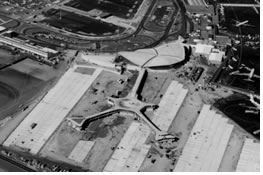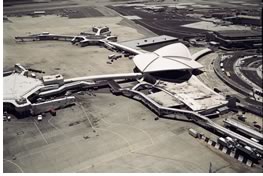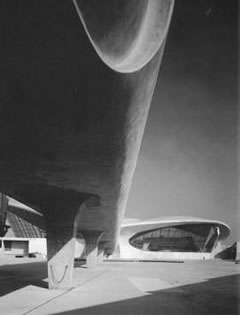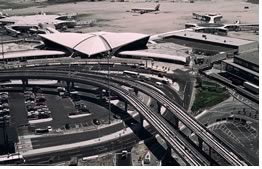
 Even
a cursory glance at the current condition of the TWA Terminal at New York
City's JFK Airport tells you that it ain't what it used to be: the proud
Modern monument to the Jet Age designed by master architect Eero Saarinen
in 1962. "Terminal 5," as it is known in the parlance of the
Port Authority of New York and New Jersey, which holds stewardship of
the airport, has rushed to keep up with the increasing demands of air
travel. Along the way, it has acquired concrete and sheet metal and all
other kinds of accretions and add-ons just to handle burgeoning amounts
of planes, cars, baggage—and people.
Even
a cursory glance at the current condition of the TWA Terminal at New York
City's JFK Airport tells you that it ain't what it used to be: the proud
Modern monument to the Jet Age designed by master architect Eero Saarinen
in 1962. "Terminal 5," as it is known in the parlance of the
Port Authority of New York and New Jersey, which holds stewardship of
the airport, has rushed to keep up with the increasing demands of air
travel. Along the way, it has acquired concrete and sheet metal and all
other kinds of accretions and add-ons just to handle burgeoning amounts
of planes, cars, baggage—and people.
 All
appear to have suffered, not least the building itself, which can no longer
keep up with the demands of air travel and has fallen into disrepair.
Its owner, Trans World Airlines, bought out in June by American Airlines,
is uncertain of its own fate and, by extension, that of its future relationship
with the Saarinen terminal.
All
appear to have suffered, not least the building itself, which can no longer
keep up with the demands of air travel and has fallen into disrepair.
Its owner, Trans World Airlines, bought out in June by American Airlines,
is uncertain of its own fate and, by extension, that of its future relationship
with the Saarinen terminal.
Many elements of the existing building simply render it not a good terminal from a passenger's point of view, says Ted Kleiner, AIA, the Port Authority's assistant director for capital programs. There is no weather protection on the landside of the building, where arrivals and departures are mixed, as opposed to the now-standard bilevel departures and arrivals roadways for air terminals.

TWA needed to add a baggage-handling wing to the building on the airside, blocking views arriving passengers would have had to the terminal. Inside, ticketing modules are underused, waiting areas are minuscule and therefore overcrowded, and the lengthy jetways are not models of accessible design. The challenge becomes providing customer service in a functional terminal—while preserving a landmark.
 Master
plan offers the best chance for survival
Master
plan offers the best chance for survival
Kennedy Airport, home of the beleaguered building, serves more than 30
million passengers each year, some 18 million of whom are international
travelers—more than any other airport in the world. The airport is
undergoing a $10 billion master plan, which includes renovation or replacement
of each of its 10 terminals and could have been the impetus for Terminal
5's demise midst the space-starved airport. Actually, though, the Port
Authority's master plan offers the Saarinen design—at least the most
important parts of it—a great chance for survival; likely the best
chance it will get. It seems clear that the building can no longer function
as a terminal. However, because the Port Authority has conceived the airport
renovation as a whole, there is hope and room for finding a new use for
the landmark building.
Part of the Port Authority's holistic approach includes a regionally connected train system, operational next year, that will connect the airport terminals with Jamaica station, hub of the Long Island Railroad. This vital connection provides easy access to midtown Manhattan's Penn Station, Brooklyn, and the length of Long Island. The air train will also make any terminal only minutes away from any other terminal, says Kleiner, allowing the 10 buildings—each designed independently now and in the original plan—to function as a whole.
 The
plan
The
plan
The concept of uniting the terminals into a whole allowed conception of
Terminal 5 and Terminal 6 as one project, which in turn allowed freer
thinking of how to preserve the Saarinen building while developing the
up-to-date terminal needed to handle today's air traffic. As is true with
the entire Kennedy Airport redesign, says, Robert I. Davidson, FAIA, Port
Authority's chief architect, the Terminals 5/6 project needs to balance
three elements:
1. Landside/landscape approach to the terminal
2. The terminal itself
3. Airside/boarding and servicing of the aircraft itself.
The plan to restore Terminals 5 and 6 is a public-private partnership between the Port Authority and major airlines, United Airlines chief among them. United has hired William Nicholas Bodouva & Associates of New York City, designer of JFK Airport's much acclaimed Terminal 1, to design the new facility. New York City's award-winning Beyer Blinder Belle will work on restoration of the Saarinen terminal.
 Pressure
from preservationists to save the terminal led to extensive modifications
in the Port Authority's original plan. Most significantly, the agency
reworked its roadways into a fairly complex pattern that includes a departure
lane that takes cars under the TWA Terminal's umbilical jetways, allowing
the umbilicals to be saved. Preservation of the jetways allows for preservation
of Saarinen's original parti, which called for entry into the main building
and a processional departure down long hallways to a destination—now
to be the new terminal.
Pressure
from preservationists to save the terminal led to extensive modifications
in the Port Authority's original plan. Most significantly, the agency
reworked its roadways into a fairly complex pattern that includes a departure
lane that takes cars under the TWA Terminal's umbilical jetways, allowing
the umbilicals to be saved. Preservation of the jetways allows for preservation
of Saarinen's original parti, which called for entry into the main building
and a processional departure down long hallways to a destination—now
to be the new terminal.
Davidson explains that the major elements of the
current plan include:
• Preserving the Saarinen terminal for a new use (restaurant, conference
center, and museum are among the alternatives suggested) and connecting
it to the new facility via the intact jetways. This is the driver that
keeps intact Saarinen's original parti.
• Removing the airside accretions—including the makeshift baggage
handling wing—and opening this outdoor space as a public plaza

• Keeping the profile of the new terminal as low as functional, so it does not overwhelm the landmark building. Depression of the aforementioned roadway on the landside of the TWA Terminal allows for them to be staggered. Although not directly stacked, the arrangement still achieves bilevel arrival and departure roads as well as this lower profile for the new terminal.

Davidson says these major elements, plus connection to the new rail and road systems will allow the Saarinen Terminal to serve as the centerpiece for JFK Airport.
Concessions must
be made
Bringing the terminal up to modern functionality requires concessions
in its original design. Most significantly, its two outlying boarding
pods (one of which is covered by the city's landmark status; the other
was added later) need to be demolished to make room for the new terminal.
In their present form, they cannot service today's larger aircraft. In
April of this year, the State Office of Parks, Recreation and Historic
Preservation approved the Port Authority's plans to remove the pods, despite
objections from the New York City Landmarks Commission, which in this
case can suggest changes but not mandate them. Under federal law, the
state's historic preservation agency is responsible for approving changes
to landmarks when federal money is involved. The Federal Aviation Administration
also will review plans for the building.
On the other hand, the plan offers the building a new lease on life and returns to it its all-important context that has gotten crowded by makeshift additions. In a way, although the landmark building will share its space with the new terminal, the proposed design offers it more contextual breathing room than it has now by returning its surround in the form of an airside plaza and connections to the landside road and railways.
 "These
is a lot of fluidity here," says Kleiner, based on the notion that
there are still "wild cards" that will affect the timing and
construction of the project. The status of TWA and how and if it will
continue to function is a wild card, as is finding a new owner who will
respect the landmark and treat it right. "We plan to write a very
tight preservation scope," Kleiner says. However, it is this unknown
that worries preservationists most. They fear that if the building is
vacated, it will deteriorate to the point that the Port Authority will
need to tear it down (click here).
"These
is a lot of fluidity here," says Kleiner, based on the notion that
there are still "wild cards" that will affect the timing and
construction of the project. The status of TWA and how and if it will
continue to function is a wild card, as is finding a new owner who will
respect the landmark and treat it right. "We plan to write a very
tight preservation scope," Kleiner says. However, it is this unknown
that worries preservationists most. They fear that if the building is
vacated, it will deteriorate to the point that the Port Authority will
need to tear it down (click here).
Walker S. Johnson, FAIA, chair of the AIA Historic Resources Committee, says, "While we applaud the attempts of the Port Authority to preserve the main building, we cannot forget that its fate is not cast in stone. There still is no tenant for the terminal." To offer protection for other icons of the Modern Movement, Johnson also points to the need for the National Register to reduce the age requirement for buildings to become National Historic Landmarks from the current 50 years to 25 years, as England and Canada already have done.
Moving Ahead
If TWA and a new owner are the wild cards, the ace-in-the-hole is the
solidity of the design concept balancing customer service and transportation.
The Port Authority met with the federal-level Advisory Council for Historic
Preservation on July 23. The Council has 30 days to approve the state-approved
plan or ask for more public hearings on the terminal design. In the meantime,
overall plans for the overall airport are moving ahead. United Airlines
will build the new terminal with an eye toward opening in 2005. Jet Blue,
an up-and-comer airline that has made JFK Airport its hub, plans also
to occupy the building and has retained Bodouvas as its architect.
There are many precedents of successful adaptive use in which the original structure could no longer support its intended use and has been cradled by a respectful modern successor, points out preservation architect John J. Cullinane, AIA, Annapolis, Md. The AIA's own original headquarters, the 1801 Octagon House, now preserved as the Octagon Museum and foiled by the 1973 headquarters, albeit of much smaller scale, demonstrates clearly how the concept employed for the Saarinen's terminal could work.
 Our
profession could find a lot to be proud of in this process—not the
least of which is the collaboration among the public and private architects.
The preservationists have led public opinion, perhaps evoking concessions
that led to more of the TWA building—and the parti that Saarinen
intended—being preserved and incorporated into the design. The Port
Authority architects have demonstrated vision and balance in finding a
way to preserve the TWA Terminal and make it part of the new master plan.
They are working with William Nicholas Bodouva & Associates, and Beyer
Blinder Belle, whose track records give every indication of how the old
terminal will be preserved—skillfully and beautifully—and the
new terminal will be designed—skillfully and beautifully.
Our
profession could find a lot to be proud of in this process—not the
least of which is the collaboration among the public and private architects.
The preservationists have led public opinion, perhaps evoking concessions
that led to more of the TWA building—and the parti that Saarinen
intended—being preserved and incorporated into the design. The Port
Authority architects have demonstrated vision and balance in finding a
way to preserve the TWA Terminal and make it part of the new master plan.
They are working with William Nicholas Bodouva & Associates, and Beyer
Blinder Belle, whose track records give every indication of how the old
terminal will be preserved—skillfully and beautifully—and the
new terminal will be designed—skillfully and beautifully.
Copyright 2001 The American Institute of Architects. All rights reserved.
![]()
|
Saarinen's TWA Terminal and the Moment of Truth. Full Story DOCOMOMO Helps Safeguard Saarinen's TWA Terminal Full Story Photos courtesy of the Port Authority of New York and New Jersey. |
|